CSRNet: Dilated Convolutional Neural Networks for Understanding the Highly
Congested Scenes
Yuhong Li1,2, Xiaofan Zhang1, Deming Chen1
1University of Illinois at Urbana-Champaign
2Beijing University of Posts and Telecommunications
{leeyh,xiaofan3,dchen}@illinois.edu
8
1
0
2
r
p
A
1
1
]
V
C
.
s
c
[
4
v
2
6
0
0
1
.
2
0
8
1
:
v
i
X
r
a
Abstract
We propose a network for Congested Scene Recognition
called CSRNet to provide a data-driven and deep learning
method that can understand highly congested scenes and
perform accurate count estimation as well as present high-
quality density maps. The proposed CSRNet is composed
of two major components: a convolutional neural network
(CNN) as the front-end for 2D feature extraction and a di-
lated CNN for the back-end, which uses dilated kernels to
deliver larger reception fields and to replace pooling opera-
tions. CSRNet is an easy-trained model because of its pure
convolutional structure. We demonstrate CSRNet on four
datasets (ShanghaiTech dataset, the UCF CC 50 dataset,
the WorldEXPO’10 dataset, and the UCSD dataset) and
we deliver the state-of-the-art performance. In the Shang-
haiTech Part B dataset, CSRNet achieves 47.3% lower
Mean Absolute Error (MAE) than the previous state-of-the-
art method. We extend the targeted applications for count-
ing other objects, such as the vehicle in TRANCOS dataset.
Results show that CSRNet significantly improves the output
quality with 15.4% lower MAE than the previous state-of-
the-art approach.
1. Introduction
Growing number of network models have been devel-
oped [1, 2, 3, 4, 5] to deliver promising solutions for crowd
flows monitoring, assembly controlling, and other security
services. Current methods for congested scenes analysis are
developed from simple crowd counting (which outputs the
number of people in the targeted image) to density map pre-
senting (which displays characteristics of crowd distribu-
tion)
[6]. This development follows the demand of real-
life applications since the same number of people could
have completely different crowd distributions (as shown in
Fig. 1), so that just counting the number of crowds is not
enough. The distribution map helps us for getting more ac-
curate and comprehensive information, which could be crit-
ical for making correct decisions in high-risk environments,
such as stampede and riot. However, it is challenging to
generate accurate distribution patterns. One major difficulty
Figure 1. Pictures in first row show three images all containing 95
people in ShanghaiTech Part B dataset [18], while having totally
different spatial distributions. Pictures in second row show their
density maps.
comes from the prediction manner: since the generated den-
sity values follow the pixel-by-pixel prediction, output den-
sity maps must include spatial coherence so that they can
present the smooth transition between nearest pixels. Also,
the diversified scenes, e.g., irregular crowd clusters and dif-
ferent camera perspectives, would make the task difficult,
especially for using traditional methods without deep neu-
ral networks (DNNs). The recent development of congested
scene analysis relays on DNN-based methods because of
the high accuracy they have achieved in semantic segmen-
tation tasks [7, 8, 9, 10, 11] and the significant progress they
have made in visual saliency [12]. The additional bonus of
using DNNs comes from the enthusiastic hardware com-
munity where DNNs are rapidly investigated and imple-
mented on GPUs [13], FPGAs [14, 15, 16], and ASICs [17].
Among them, the low-power, small-size schemes are es-
pecially suitable for deploying congested scene analysis in
surveillance devices.
Previous works for congested scene analysis are mostly
based on multi-scale architectures [4, 5, 18, 19, 20]. They
have achieved high performance in this field but the de-
signs they used also introduce two significant disadvantages
when networks go deeper:
large amount of training time
and non-effective branch structure (e.g., multi-column CNN
(MCNN) in [18]). We design an experiment to demon-
strate that the MCNN does not perform better compared to a
�
deeper, regular network in Table 1. The main reason of us-
ing MCNN in [18] is the flexible receptive fields provided
by convolutional filters with different sizes across the col-
umn. Intuitively, each column of MCNN is dedicated to a
certain level of congested scene. However, the effectiveness
of using MCNN may not be prominent. We present Fig. 2
to illustrate the features learned by three separated columns
(representing large, medium, and small receptive fields) in
MCNN and evaluate them with ShanghaiTech Part A [18]
dataset. The three curves in this figure share very similar
patterns (estimated error rate) for 50 test cases with different
congest densities meaning that each column in such branch
structure learn nearly identical features. It performs against
the original intention of the MCNN design for learning dif-
ferent features for each column.
In this paper, we design a deeper network called CSR-
Net for counting crowd and generating high-quality den-
sity maps. Unlike the latest works such as [4, 5] which
use the deep CNN for ancillary, we focus on designing a
CNN-based density map generator. Our model uses pure
convolutional layers as the backbone to support input im-
ages with flexible resolutions. To limit the network com-
plexity, we use the small size of convolution filters (like
3 × 3) in all layers. We deploy the first 10 layers from
VGG-16 [21] as the front-end and dilated convolution lay-
ers as the back-end to enlarge receptive fields and extract
deeper features without losing resolutions (since pooling
layers are not used). By taking advantage of such innovative
structure, we outperform the state-of-the-art crowd count-
ing solutions (a MCNN based solution called CP-CNN [5])
with 7%, 47.3%, 10.0%, and 2.9% lower Mean Abso-
lute Error (MAE) in ShanghaiTech [18] Part A, Part B,
UCF CC 50 [22], and WorldExpo’10 [3] datasets respec-
tively. Also, we achieve high performance on the UCSD
dataset [23] with 1.16 MAE. After extending this work to
vehicle counting on TRANCOS dataset [20], we achieve
15.4% lower MAE than the current best approach, called
FCN-HA [24].
The rest of the paper is structured as follows. Sec. 2
presents the previous works for crowd counting and den-
sity map generation. Sec. 3 introduces the architecture and
configuration of our model while Sec. 4 presents the exper-
imental results on several datasets. In Sec. 5, we conclude
the paper.
2. Related work
Following the idea proposed by Loy et al. [25], the po-
tential solutions for crowd scenes analysis can be classified
into three categories: detection-based methods, regression-
based methods, and density estimation-based methods. By
combining the deep learning,
the CNN-based solutions
show even stronger ability in this task and outperform the
traditional methods.
Figure 2. The estimated error of 50 samples from the testing set
in ShanghaiTech Part A [18] generated by the three pre-trained
columns of MCNN. Small, Medium, Large respectively stand for
the columns with small, medium or large kernels in the MCNN.
Method
Col. 1 of MCNN
Col. 2 of MCNN
Col. 3 of MCNN
MCNN Total
A deeper CNN
Parameters MAE MSE
206.8
239.0
230.2
185.9
142.2
57.75k
45.99k
25.14k
127.68k
83.84k
141.2
160.5
153.7
110.2
93.0
Table 1. To demonstrate that MCNN [18] may not be the best
choice, we design a deeper, single-column network with fewer
parameters compared to MCNN. The architecture of the pro-
posed small network is: CR(32, 3) − M − CR(64, 3) − M −
CR(64, 3)−M−CR(32, 3)−CR(32, 3)−CR(1, 1). CR(m, n)
represents the convolutional layer with m filters whose size is n×n
followed by the ReLu layer. M is the max-pooling layer. Results
show that the single-column version achieves higher performance
on ShanghaiTech Part A dataset [18] with the lowest MAE and
Mean Squared Error (MSE)
2.1. Detection-based approaches
Most of the early researches focus on detection-based
approaches using a moving-window-like detector to detect
people and count their number [26]. These methods re-
quire well-trained classifiers to extract low-level features
from the whole human body (like Haar wavelets [27] and
HOG (histogram oriented gradients) [28]). However, they
perform poorly on highly congested scenes since most of
the targeted objects are obscured. To tackle this problem,
researchers detect particular body parts instead of the whole
body to complete crowd scenes analysis [29].
2.2. Regression-based approaches
Since detection-based approaches can not be adapted
to highly congested scenes,
researchers try to deploy
regression-based approaches to learn the relations among
extracted features from cropped image patches, and then
calculate the number of particular objects. More features,
�
such as foreground and texture features, have been used for
generating low-level information [30]. Following similar
approaches, Idrees et al. [22] propose a model to extract
features by employing Fourier analysis and SIFT (Scale-
invariant feature transform) [31] interest-point based count-
ing.
2.3. Density estimation-based approaches
When executing the regression-based solution, one crit-
ical feature, called saliency, is overlooked which causes in-
accurate results in local regions. Lempitsky et al. [32] pro-
pose a method to solve this problem by learning a linear
mapping between features in the local region and its object
density maps. It integrates the information of saliency dur-
ing the learning process. Since the ideal linear mapping is
hard to obtain, Pham et al. [33] use random forest regression
to learn a non-linear mapping instead of the linear one.
2.4. CNN-based approaches
Literature also focuses on the CNN-based approaches
to predict the density map because of its success in clas-
sification and recognition [34, 21, 35].
In the work pre-
sented by Walach and Wolf [36], a method is demonstrated
with selective sampling and layered boosting.
Instead of
using patch-based training, Shang et al. [37] try an end-to-
end regression method using CNNs which takes the entire
image as input and directly outputs the final crowd count.
Boominathan et al. [19] present the first work purely us-
ing convolutional networks and dual-column architecture
for generating density map. Marsden et al. [38] explore
single-column fully convolutional networks while Sindagi
et al. [39] propose a CNN which uses the high-level prior in-
formation to boost the density prediction performance. An
improved structure is proposed by Zhang et al. [18] who
introduce a multi-column based architecture (MCNN) for
crowd counting. Similar idea is shown in Onoro and Sas-
tre [20] where a scale-aware, multi-column counting model
called Hydra CNN is presented for object density estima-
tion. It is clear that the CNN-based solutions outperform
the previous works mentioned in Sec. 2.1 to 2.3.
2.5. Limitations of the state-of-the-art approaches
Most recently, Sam et al. [4] propose the Switch-CNN
using a density level classifier to choose different regres-
sors for particular input patches. Sindagi et al. [5] present
a Contextual Pyramid CNN, which uses CNN networks to
estimate context at various levels for achieving lower count
error and better quality density maps. These two solutions
achieve the state-of-the-art performance, and both of them
used multi-column based architecture (MCNN) and den-
sity level classifier. However, we observe several disad-
vantages in these approaches: (1) Multi-column CNNs are
hard to train according to the training method described in
work [18]. Such bloated network structure requires more
time to train. (2) Multi-column CNNs introduce redundant
structure as we mentioned in Sec. 1. Different columns
seem to perform similarly without obvious differences. (3)
Both solutions require density level classifier before send-
ing pictures in the MCNN. However, the granularity of den-
sity level is hard to define in real-time congested scene anal-
ysis since the number of objects keeps changing with a large
range. Also, using a fine-grained classifier means more
columns need to be implemented which makes the design
more complicated and causes more redundancy. (4) These
works spend a large portion of parameters for density level
classification to label the input regions instead of allocating
parameters to the final density map generation. Since the
branch structure in MCNN is not efficient, the lack of pa-
rameters for generating density map lowers the final accu-
racy. Taking all above disadvantages into consideration, we
propose a novel approach to concentrate on encoding the
deeper features in congested scenes and generating high-
quality density map.
3. Proposed Solution
The fundamental idea of the proposed design is to de-
ploy a deeper CNN for capturing high-level features with
larger receptive fields and generating high-quality density
maps without brutally expanding network complexity.
In
this section, we first introduce the architecture we proposed,
and then we present the corresponding training methods.
3.1. CSRNet architecture
Following the similar idea in [19, 4, 5], we choose VGG-
16 [21] as the front-end of CSRNet because of its strong
transfer learning ability and its flexible architecture for eas-
ily concatenating the back-end for density map generation.
In CrowdNet [19], the authors directly carve the first 13 lay-
ers from VGG-16 and add a 1 × 1 convolutional layer as
output layer. The absence of modifications results in very
weak performance. Other architectures, such as [4], uses
VGG-16 as the density level classifier for labeling input im-
ages before sending them to the most suitable column of
the MCNN, while the CP-CNN [5] incorporates the result
of classification with the features from density map gen-
erator. In these cases, the VGG-16 performs as an ancil-
lary without significantly boosting the final accuracy.
In
this paper, we first remove the classification part of VGG-
16 (fully-connected layers) and build the proposed CSRNet
with convolutional layers in VGG-16. The output size of
this front-end network is 1/8 of the original input size. If
we continue to stack more convolutional layers and pooling
layers (basic components in VGG-16), output size would
be further shrunken, and it is hard to generate high-quality
density maps. Inspired by the works [10, 11, 40], we try
to deploy dilated convolutional layers as the back-end for
�
extracting deeper information of saliency as well as main-
taining the output resolution.
3.1.1 Dilated convolution
One of the critical components of our design is the di-
lated convolutional layer. A 2-D dilated convolution can be
defined as follow:
M
N
y(m, n) =
x(m + r × i, n + r × j)w(i, j)
(1)
Figure 3. 3 × 3 convolution kernels with different dilation rate as
1, 2, and 3.
i=1
j=1
y(m, n) is the output of dilated convolution from input
x(m, n) and a filter w(i, j) with the length and the width
of M and N respectively. The parameter r is the dilation
rate. If r = 1, a dilated convolution turns into a normal
convolution.
Dilated convolutional layers have been demonstrated in
segmentation tasks with significant improvement of accu-
racy [10, 11, 40] and it is a good alternative of pooling
layer. Although pooling layers (e.g., max and average pool-
ing) are widely used for maintaining invariance and con-
trolling overfitting, they also dramatically reduce the spatial
resolution meaning the spatial information of feature map
is lost. Deconvolutional layers [41, 42] can alleviate the
loss of information, but the additional complexity and ex-
ecution latency may not be suitable for all cases. Dilated
convolution is a better choice, which uses sparse kernels (as
shown in Fig. 3) to alternate the pooling and convolutional
layer. This character enlarges the receptive field without
increasing the number of parameters or the amount of com-
putation (e.g., adding more convolutional layers can make
larger receptive fields but introduce more operations).
In
dilated convolution, a small-size kernel with k × k filter is
enlarged to k + (k − 1)(r − 1) with dilated stride r. Thus
it allows flexible aggregation of the multi-scale contextual
information while keeping the same resolution. Examples
can be found in Fig. 3 where normal convolution gets 3 × 3
receptive field and two dilated convolutions deliver 5 × 5
and 7 × 7 receptive fields respectively.
For maintaining the resolution of feature map, the di-
lated convolution shows distinct advantages compared to
the scheme of using convolution + pooling + deconvolu-
tion. We pick one example for illustration in Fig. 4. The
input is an image of crowds, and it is processed by two
approaches separately for generating output with the same
size. In the first approach, input is downsampled by a max
pooling layer with factor 2, and then it is passed to a convo-
lutional layer with a 3× 3 Sobel kernel. Since the generated
feature map is only 1/2 of the original input, it needs to be
upsampled by the deconvolutional layer (bilinear interpola-
tion). In the other approach, we try dilated convolution and
adapt the same 3 × 3 Sobel kernel to a dilated kernel with a
Figure 4. Comparison between dilated convolution and max-
pooling, convolution, upsampling. The 3 × 3 Sobel kernel is used
in both operations while the dilation rate is 2.
factor = 2 stride. The output is shared the same dimension
as the input (meaning pooling and deconvolutional layers
are not required). Most importantly, the output from dilated
convolution contains more detailed information (referring
to the portions we zoom in).
3.1.2 Network Configuration
We propose four network configurations of CSRNet in
Table 3 which have the same front-end structure but differ-
ent dilation rate in the back-end. Regarding the front-end,
we adapt a VGG-16 network [21] (except fully-connected
layers) and only use 3 × 3 kernels. According to [21], us-
ing more convolutional layers with small kernels is more
efficient than using fewer layers with larger kernels when
targeting the same size of receptive field .
By removing the fully-connected layers, we try to deter-
mine the number of layers we need to use from VGG-16.
The most critical part relays on the tradeoff between ac-
curacy and the resource overhead (including training time,
memory consumption, and the number of parameters). Ex-
periment shows a best tradeoff can be achieved when keep-
ing the first ten layers of VGG-16 [21] with only three pool-
ing layers instead of five to suppress the detrimental effects
on output accuracy caused by the pooling operation. Since
the output (density maps) of CSRNet is smaller (1/8 of in-
put size), we choose bilinear interpolation with the factor
of 8 for scaling and make sure the output shares the same
�
Dataset
ShanghaiTech Part A [18]
UCF CC 50 [22]
ShanghaiTech Part B [18]
TRANCOS [44]
The WorldExpo’10 [3]
The UCSD [23]
Generating method
Geometry-adaptive kernels
Fixed kernel: σ = 15
Fixed kernel: σ = 10
Fixed kernel: σ = 3
Table 2. The ground truth generating methods for different datasets
resolution as the input image. With the same size, CSR-
Net generated results are comparable with the ground truth
results using the PSNR (Peak Signal-to-Noise Ratio) and
SSIM (Structural Similarity in Image [43]).
3.2. Training method
In this section, we provide specific details of CSRNet
training. By taking advantage of the regular CNN network
(without branch structures), CSRNet is easy to implement
and fast to deploy.
3.2.1 Ground truth generation
Following the method of generating density maps in
[18], we use the geometry-adaptive kernels to tackle the
highly congested scenes. By blurring each head annotation
using a Gaussian kernel (which is normalized to 1), we gen-
erate the ground truth considering the spatial distribution of
all images from each dataset. The geometry-adaptive kernel
is defined as:
N
i=1
F (x) =
δ(x − xi) × Gσi(x), with σi = βdi
(2)
For each targeted object xi in the ground truth δ, we use
di to indicate the average distance of k nearest neighbors.
To generate the density map, we convolve δ(x − xi) with
a Gaussian kernel with parameter σi (standard deviation),
where x is the position of pixel in the image. In experiment,
we follow the configuration in [18] where β = 0.3 and
k = 3. For input with sparse crowd, we adapt the Gaussian
kernel to the average head size to blur all the annotations.
The setups for different datasets are shown in Table 2.
3.2.2 Data augmentation
We crop 9 patches from each image at different loca-
tions with 1/4 size of the original image. The first four
patches contain four quarters of the image without overlap-
ping while the other five patches are randomly cropped from
the input image. After that, we mirror the patches so that we
double the training set.
Configurations of CSRNet
A
B
C
D
input(unfixed-resolution color image)
front-end
(fine-tuned from VGG-16)
conv3-64-1
conv3-64-1
max-pooling
conv3-128-1
conv3-128-1
max-pooling
conv3-256-1
conv3-256-1
conv3-256-1
max-pooling
conv3-512-1
conv3-512-1
conv3-512-1
back-end (four different configurations)
conv3-512-1
conv3-512-1
conv3-512-1
conv3-256-1
conv3-128-1
conv3-64-1
conv3-512-2
conv3-512-2
conv3-512-2
conv3-256-2
conv3-128-2
conv3-64-2
conv3-512-2
conv3-512-2
conv3-512-2
conv3-256-4
conv3-128-4
conv3-64-4
conv3-512-4
conv3-512-4
conv3-512-4
conv3-256-4
conv3-128-4
conv3-64-4
conv1-1-1
Table 3. Configuration of CSRNet. All convolutional layers use
padding to maintain the previous size. The convolutional layers’
parameters are denoted as “conv-(kernel size)-(number of filters)-
(dilation rate)”, max-pooling layers are conducted over a 2 × 2
pixel window with stride 2.
3.2.3 Training details
We use a straightforward way to train the CSRNet as
an end-to-end structure. The first 10 convolutional layers
are fine-tuned from a well-trained VGG-16 [21]. For the
other layers, the initial values come from a Gaussian ini-
tialization with 0.01 standard deviation. Stochastic gradient
descent (SGD) is applied with fixed learning rate at 1e-6
during training. Also, we choose the Euclidean distance to
measure the difference between the ground truth and the es-
timated density map we generated which is similar to other
works [19, 18, 4]. The loss function is given as follow:
N
i=1
L(Θ) =
1
2N
Z(Xi; Θ) − Z GT
i
2
2
(3)
where N is the size of training batch and Z(Xi; Θ) is
the output generated by CSRNet with parameters shown as
Θ. Xi represents the input image while Z GT
is the ground
truth result of the input image Xi.
i
�
4. Experiments
We demonstrate our approach in five different public
datasets [18, 3, 22, 23, 44]. Compared to the previous state-
of-the-art methods [4, 5], our model is smaller, more accu-
rate, and easier to train and deploy. In this section, the eval-
uation metrics are introduced, and then an ablation study
of ShanghaiTech Part A dataset is conducted to analyze the
configuration of our model (shown in Table 3). Along with
the ablation study, we evaluate and compare our proposed
method to the previous state-of-the-art methods in all these
five datasets. The implementation of our model is based on
the Caffe framework [13].
4.1. Evaluation metrics
The MAE and the MSE are used for evaluation which
are defined as:
N
N
i=1
i=1
1
N
1
N
M AE =
M SE =
| Ci − C GT
i
|
| Ci − C GT
i
|2
(4)
(5)
L
W
where N is the number of images in one test sequence
is the ground truth of counting. Ci represents the
and C GT
estimated count which is defined as follows:
i
Ci =
zl,w
(6)
l=1
w=1
L and W show the length and width of the density map
respectively while zl,w is the pixel at (l, w) of the generated
density map. Ci means the estimated counting number for
image Xi.
We also use the PSNR and SSIM to evaluate the quality
of the output density map on ShanghaiTech Part A dataset.
To calculate the PSNR and SSIM, we follow the preprocess
given by [5], which includes the density map resizing (same
size with the original input) with interpolation and normal-
ization for both ground truth and predicted density map.
4.2. Ablations on ShanghaiTech Part A
In this subsection, we perform an ablation study to an-
alyze the four configurations of the CSRNet on Shang-
haiTech Part A dataset [18] which is a new large-scale
crowd counting dataset including 482 images for congested
scenes with 241,667 annotated persons.
It is challenging
to count from these images because of the extremely con-
gested scenes, the varied perspective, and the unfixed res-
olution. These four configurations are shown in Table 3.
CSRNet A is the network with all the dilation rate of 1.
CSRNet B and D maintain the dilation rate of 2 and 4 in
Architecture MAE MSE
116.0
CSRNet A
115.0
CSRNet B
120.58
CSRNet C
CSRNet D
120.82
69.7
68.2
71.91
75.81
Table 4. Comparison of architectures on ShanghaiTech Part A
dataset
their back-end respectively while CSRNet C combines the
dilated rate of 2 and 4. The number of parameters of these
four models are the same as 16.26M. We intend to compare
the results by using different dilation rates. After training
on Shanghai Part A dataset using the method mentioned
in Sec. 3.2, we perform the evaluation metrics defined in
Sec. 4.1. We try dropout [45] for preventing the potential
overfitting problem but there is no significant improvement.
So we do not include dropout in our model. The detailed
evaluation results are shown in Table 4, where CSRNet B
achieves the lowest error (the highest accuracy). Therefore,
we use CSRNet B as the proposed CSRNet for the follow-
ing experiments.
4.3. Evaluation and comparison
4.3.1 ShanghaiTech dataset
ShanghaiTech crowd counting dataset contains 1198 an-
notated images with a total amount of 330,165 persons [3].
This dataset consists of two parts as Part A containing 482
images with highly congested scenes randomly downloaded
from the Internet while Part B includes 716 images with
relatively sparse crowd scenes taken from streets in Shang-
hai. Our method is evaluated and compared to other six
recent works and results are shown in Table 5. It indicates
that our method achieves the lowest MAE (the highest ac-
curacy) in Part A compared to other methods and we get
7% lower MAE than the state-of-the-art solution called CP-
CNN. CSRNet also delivers 47.3% lower MAE in Part B
compared to the CP-CNN. To evaluate the quality of gen-
erated density map, we compare our method to the MCNN
and the CP-CNN using Part A dataset and we follow the
evaluation metrics in Sec. 3.2. Samples of the test cases can
be found in Fig 5. Results are shown in Table 6 which in-
dicates CSRNet achieves the highest SSIM and PSNR. We
also report the quality result of ShanghaiTech dataset in Ta-
ble 11.
4.3.2 UCF CC 50 dataset
UCF CC 50 dataset includes 50 images with different
perspective and resolutions [22]. The number of annotated
persons per image ranges from 94 to 4543 with an average
number of 1280. 5-fold cross-validation is performed fol-
lowing the standard setting in [22]. Result comparisons of
�
Method
Idrees et al. [22]
Zhang et al. [3]
MCNN [18]
Onoro et al. [20] Hydra-2s
Onoro et al. [20] Hydra-3s
Walach et al. [36]
Marsden et al. [38]
Cascaded-MTL [39]
Switching-CNN [4]
CP-CNN [5]
CSRNet (ours)
MAE MSE
541.6
419.5
498.5
467.0
509.1
377.6
425.2
333.7
465.7
371.8
341.4
364.4
424.5
338.6
397.9
322.8
318.1
439.2
320.9
295.8
266.1
397.5
Table 7. Estimation errors on UCF CC 50 dataset
are shown in Table 8. The proposed CSRNet delivers the
best accuracy in 4 out of 5 scenes and it achieves the best
accuracy on average.
Method
Chen et al. [46]
Zhang et al. [3]
MCNN [18]
Shang et al. [37]
Switching-CNN [4]
CP-CNN [5]
CSRNet (ours)
Sce.1
2.1
9.8
3.4
7.8
4.4
2.9
2.9
Sce.2
55.9
14.1
20.6
15.4
15.7
14.7
11.5
Sce.3
9.6
14.3
12.9
14.9
10.0
10.5
8.6
Sce.4
11.3
22.2
13.0
11.8
11.0
10.4
16.6
Sce.5
3.4
3.7
8.1
5.8
5.9
5.8
3.4
Avg.
16.5
12.9
11.6
11.7
9.4
8.86
8.6
Table 8. Estimated errors on the WorldExpo’10 dataset
4.3.4 The UCSD dataset
The UCSD dataset [23] has 2000 frames captured by
surveillance cameras. These scenes contain sparse crowd
varying from 11 to 46 persons per image. The region of
interest (ROI) is also provided. Because the resolution of
each frame is fixed and small (238 × 158), it is difficult to
generate a high-quality density map after frequent pooling
operations. So we preprocess the frames by using bilinear
interpolation to resize them into 952 × 632. Among the
2000 frames, we use frames 601 through 1400 as training
set and the rest of them as testing set according to [23].
Before blurring the annotation as we mentioned in Sec. 3.2,
all the frames and the corresponding dot maps are masked
with ROI. The accuracy of running UCSD dataset is shown
in Table 9 and we outperform most of the previous meth-
ods except MCNN in the MAE category. Results indicate
that our method can perform not only counting tasks for
extremely dense crowds but also tasks for relative sparse
scenes. Also, we provides the quality of generated density
map in Table 11.
4.3.5 TRANCOS dataset
Beyond the crowd counting, we setup an experiment
on the TRANCOS dataset [44] for vehicle counting to
Figure 5. The first row shows the samples of the testing set in
ShanghaiTech Part A dataset. The second row shows the ground
truth for each sample while the third row presents the generated
density map by CSRNet.
Part A
Part B
Method
Zhang et al. [3]
Marsden et al. [38]
MCNN [18]
Cascaded-MTL [39]
Switching-CNN [4]
CP-CNN [5]
CSRNet (ours)
MAE MSE MAE MSE
49.8
181.8
126.5
33.1
41.3
110.2
31.1
101.3
33.4
90.4
73.6
30.1
16.0
68.2
277.7
173.5
173.2
152.4
135.0
106.4
115.0
32.0
23.8
26.4
20.0
21.6
20.1
10.6
Table 5. Estimation errors on ShanghaiTech dataset
Method
MCNN [18]
CP-CNN [5]
CSRNet (ours)
PSNR SSIM
0.52
21.4
0.72
21.72
23.79
0.76
Table 6. Quality of density map on ShanghaiTech Part A dataset
MAE and MSE are listed in Table 7 while the quality of
generated density map can be found in Table 11.
4.3.3 The WorldExpo’10 dataset
The WorldExpo’10 dataset [3] consists of 3980 anno-
tated frames from 1132 video sequences captured by 108
different surveillance cameras. This dataset is divided into
a training set (3380 frames) and a testing set (600 frames)
from five different scenes. The region of interest (ROI) is
provided for the whole dataset. Each frame and its dot maps
are masked with ROI during preprocessing, and we train our
model following the instructions given in Sec. 3.2. Results
�
Method
Zhang et al. [3]
CCNN [20] CCNN
Switching-CNN [4]
FCN-rLSTM [24]
CSRNet (ours)
MCNN [18]
-
MAE MSE
1.60
3.31
1.51
1.62
1.54
1.16
1.07
2.10
3.02
1.47
1.35
Table 9. Estimation errors on the UCSD dataset
demonstrate the robustness and generalization of our ap-
proach. TRANCOS is a public traffic dataset containing
1244 images of different congested traffic scenes captured
by surveillance cameras with 46796 annotated vehicles.
Also, the region of interest (ROI) is provided for the eval-
uation. The perspectives of images are not fixed and the
images are collected from very different scenarios. The
Grid Average Mean Absolute Error (GAME) [44] is used
for evaluation in this test. The GAME is defined as follow:
N
(
n=1
4L
l=1
1
N
GAM E(L) =
Dl
)
− Dl
I gt
n
In
(7)
I gt
n
where N is the number of images in testing set, and Dl
In
is the estimated result of the input image n within region l.
is the corresponding ground truth result. For a specific
Dl
level L, the GAME(L) subdivides the image using a grid
of 4L non-overlapping regions which cover the full image,
and the error is computed as the sum of the MAE in each of
these regions. When L = 0, the GAME is equivalent to the
MAE metric.
We compare our approach with the previous state-of-
the-art methods [47, 32, 20, 24]. The method in [20] uses
the MCNN-like network to generate the density map while
the model in [24] deploys a combination of fully convolu-
tional neural networks (FCN) and a long short-term mem-
ory network (LSTM). Results are shown in Table 10 with
three examples shown in Fig. 6. Our model achieves a
significant improvement on four different GAME metrics.
Compared to the result from [20], CSRNet delivers 67.7%
lower GAME(0), 60.1% lower GAME(1), 48.7% lower
GAME(2), and 22.2% lower GAME(3), which is the best
solution. We also present the quality of generated density
map in Table 11.
Method
Fiaschi et al. [47]
Lempitsky et al. [32]
Hydra-3s [20]
FCN-HA [24]
CSRNet (Ours)
GAME 0
GAME 1
GAME 2
GAME 3
17.77
13.76
10.99
4.21
3.56
20.14
16.72
13.75
-
5.49
23.65
20.72
16.69
-
8.57
25.99
24.36
19.32
-
15.04
Table 10. GAME on the TRANCOS dataset
Figure 6. The first row shows samples of the testing set in TRAN-
COS [44] dataset with ROI. The second row shows the ground
truth for each sample. The third row shows the generated density
map by CSRNet.
Dataset
ShanghaiTech Part A [18]
ShanghaiTech Part B [18]
UCF CC 50 [22]
The WorldExpo’10 [3]
The UCSD [23]
TRANCOS [44]
PSNR SSIM
0.76
23.79
0.89
27.02
18.76
0.52
0.92
26.94
0.86
20.02
27.10
0.93
Table 11. The quality of density maps generated by CSRNet in 5
datasets
5. Conclusion
In this paper, we proposed a novel architecture called
CSRNet for crowd counting and high-quality density map
generation with an easy-trained end-to-end approach. We
used the dilated convolutional layers to aggregate the multi-
scale contextual information in the congested scenes. By
taking advantage of the dilated convolutional layers, CSR-
Net can expand the receptive field without losing resolution.
We demonstrated our model in four crowd counting datasets
with the state-of-the-art performance. We also extended our
model to vehicle counting task and our model achieved the
best accuracy as well.
6. Acknowledgement
This work was supported by the IBM-Illinois Center for
Cognitive Computing System Research (C3SR) - a research
collaboration as part of the IBM AI Horizons Network.
�
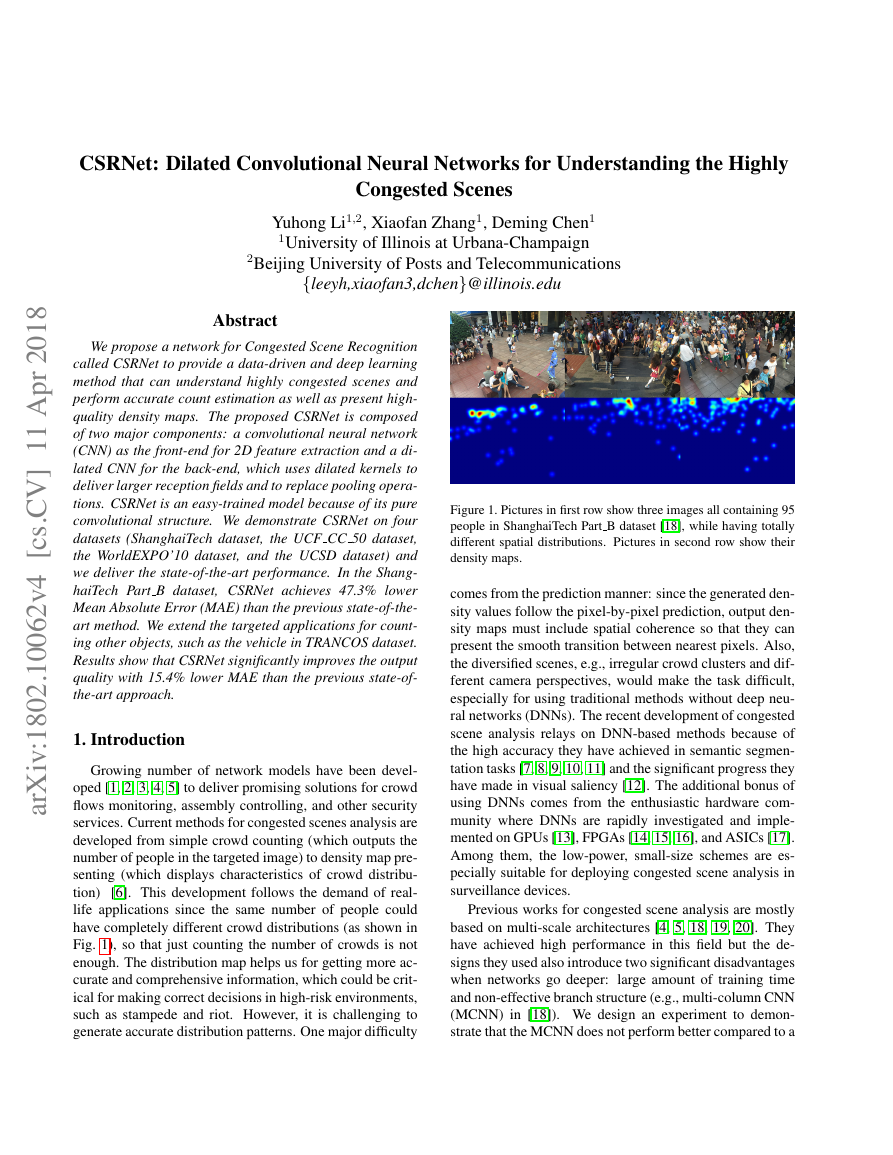
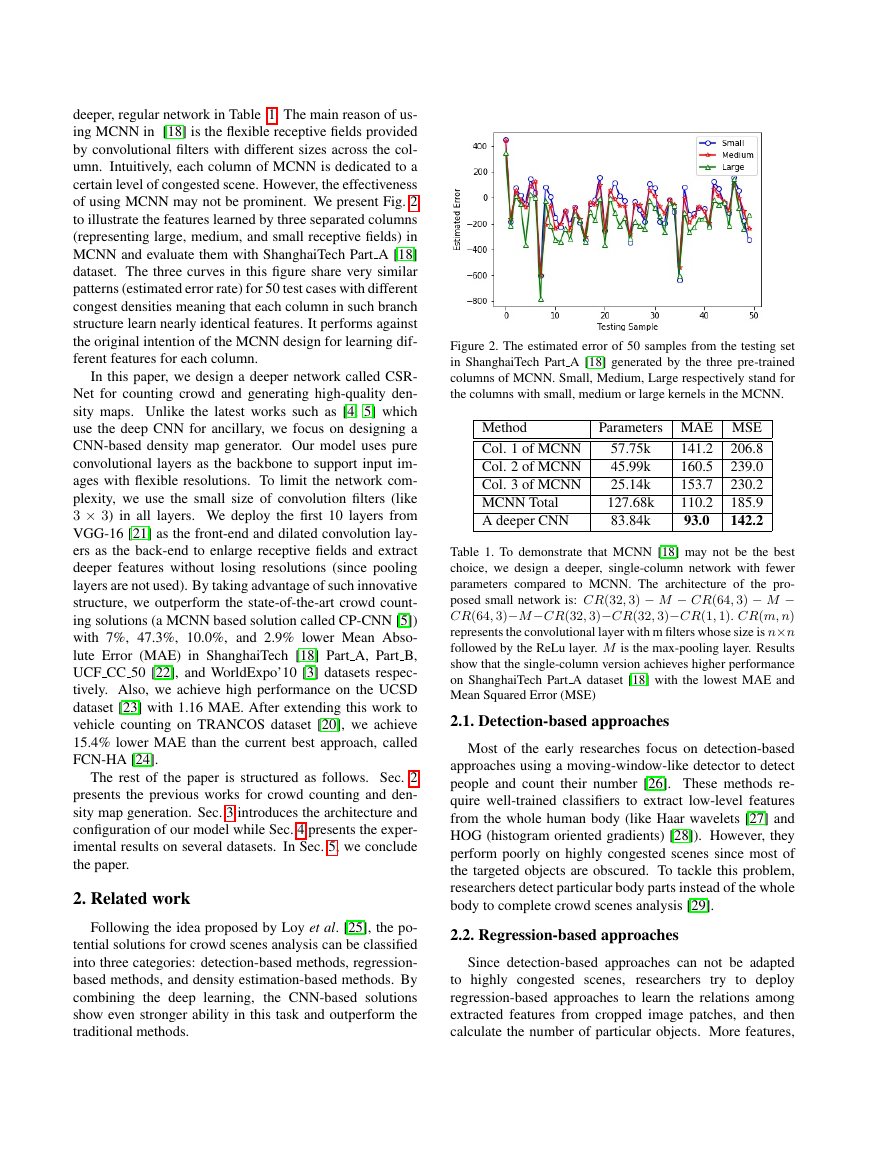
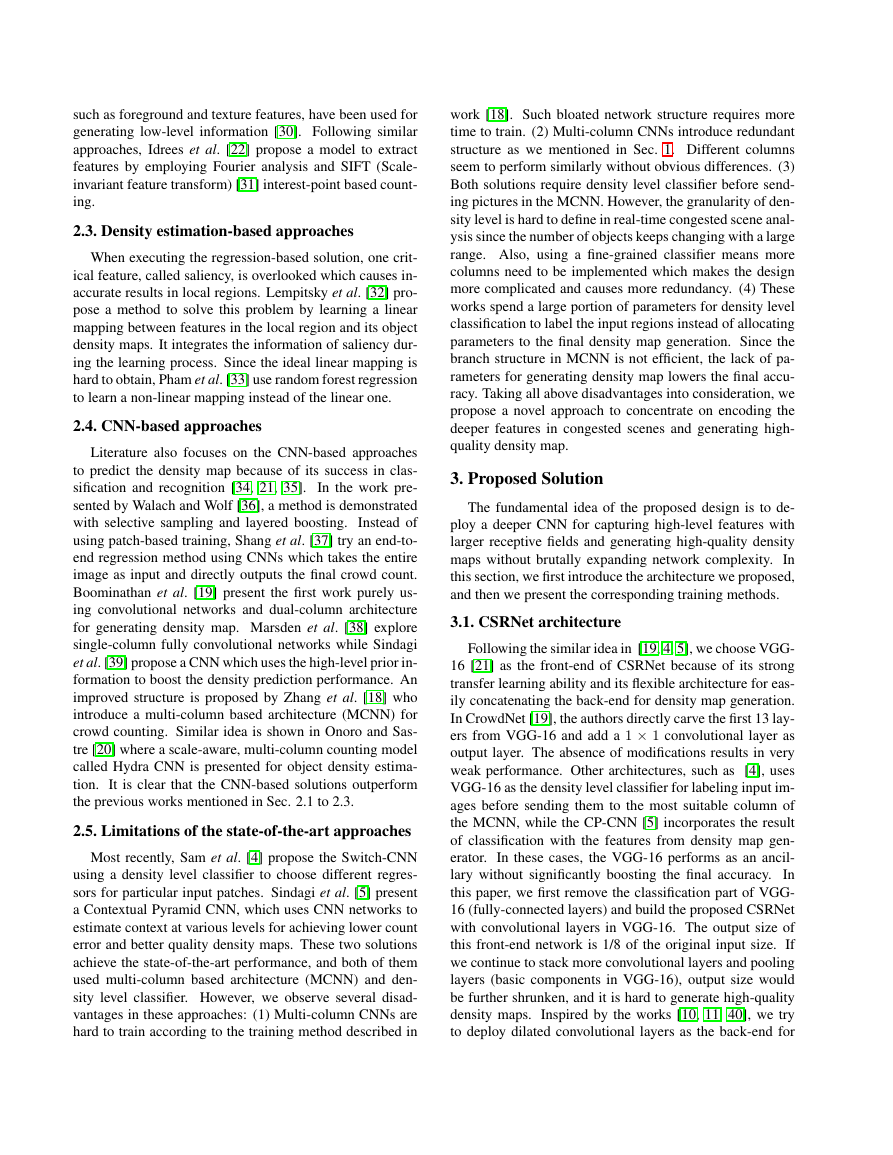
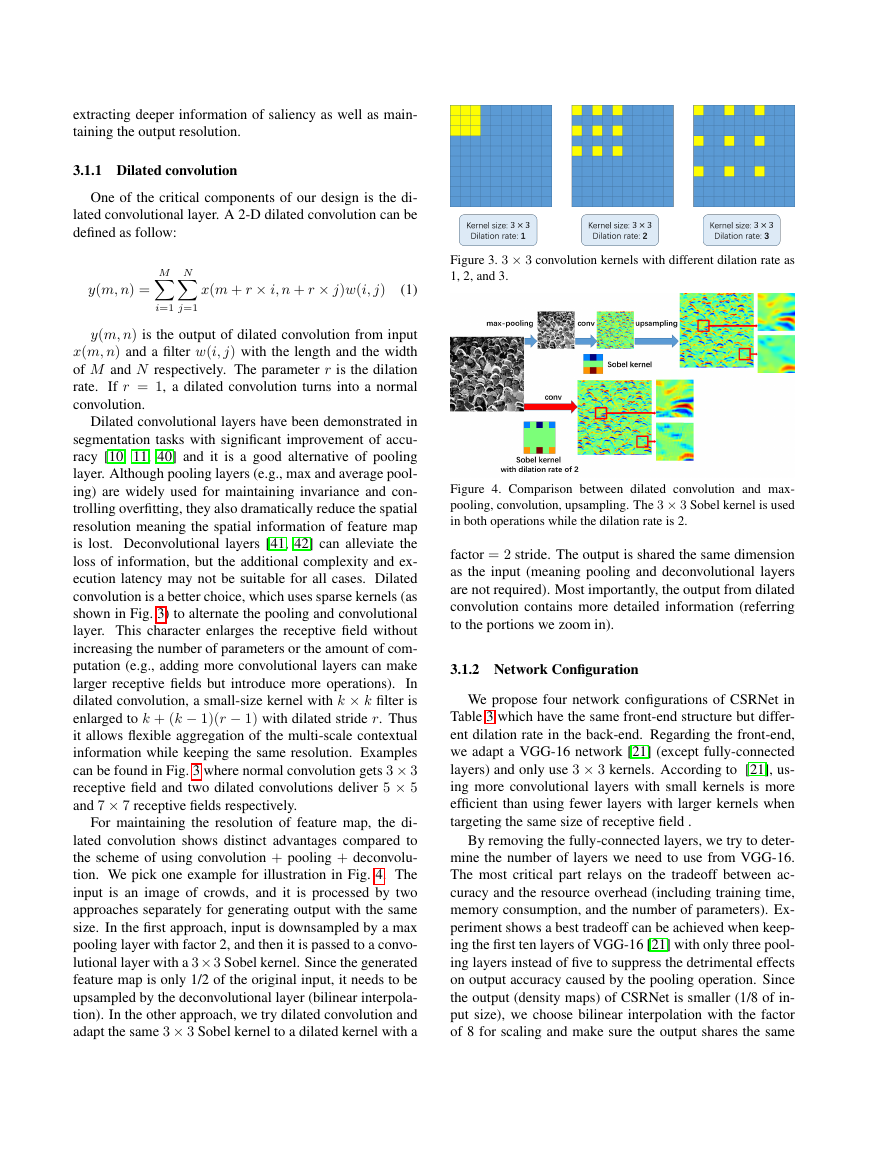
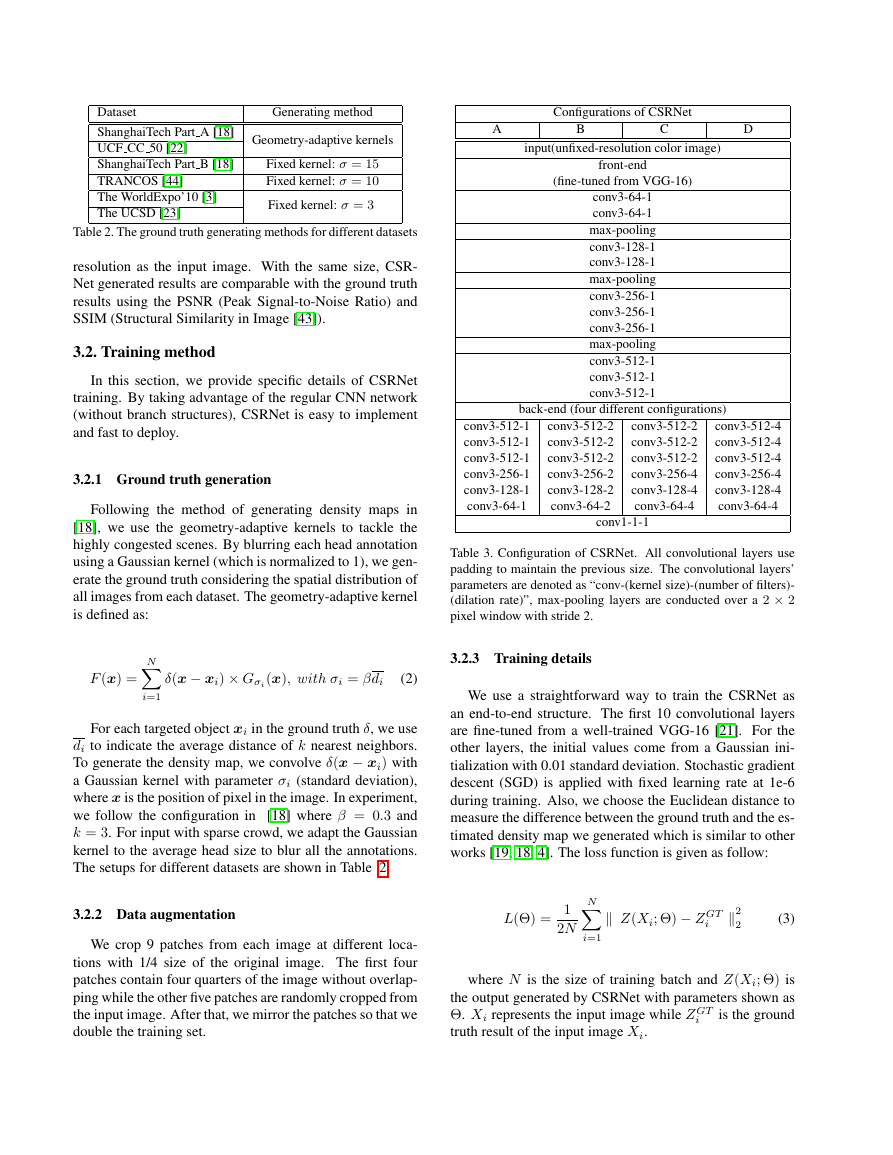
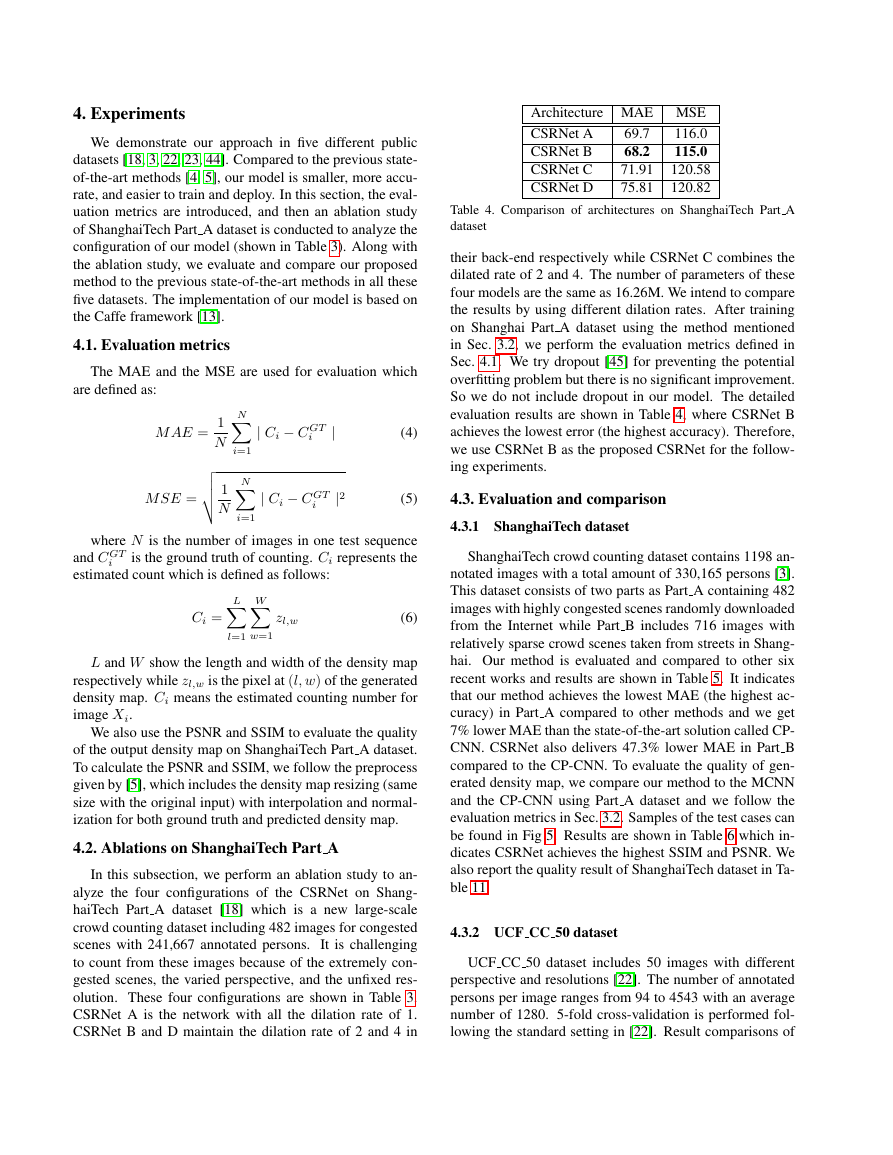
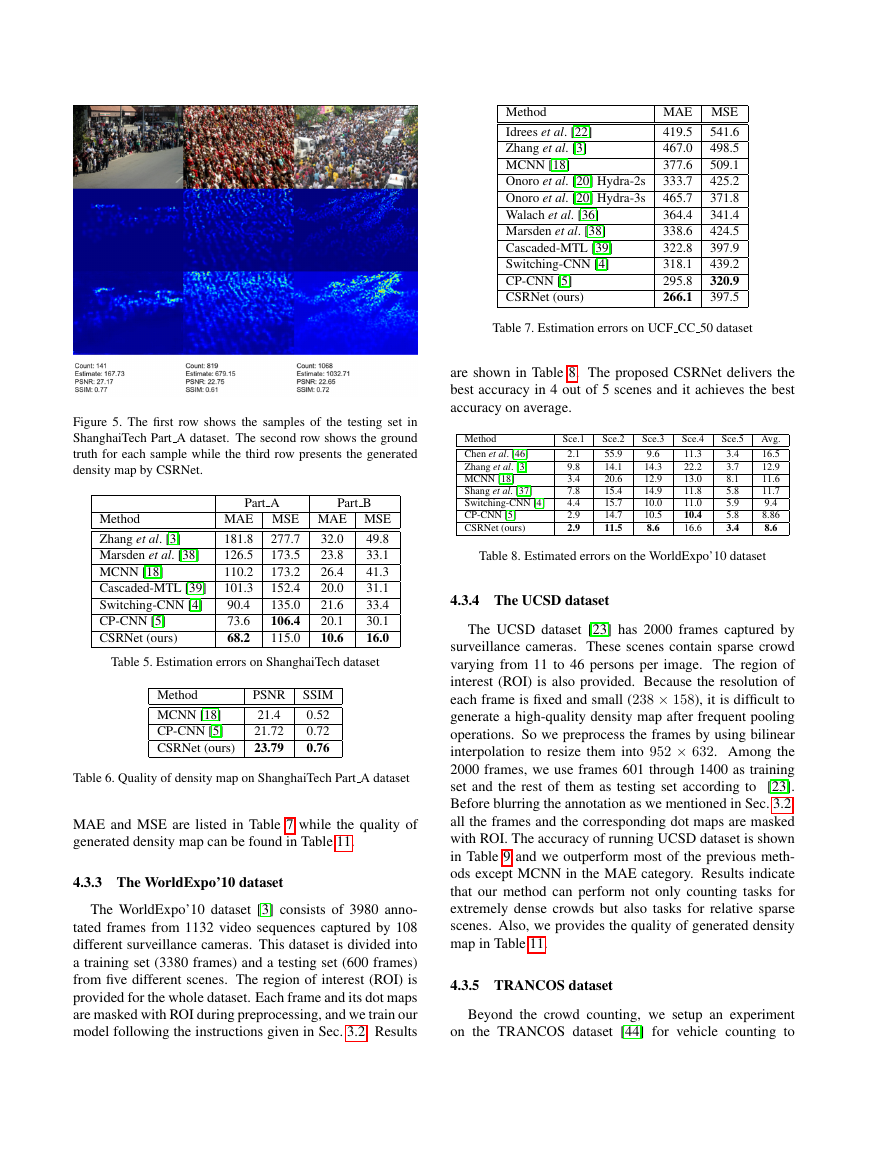
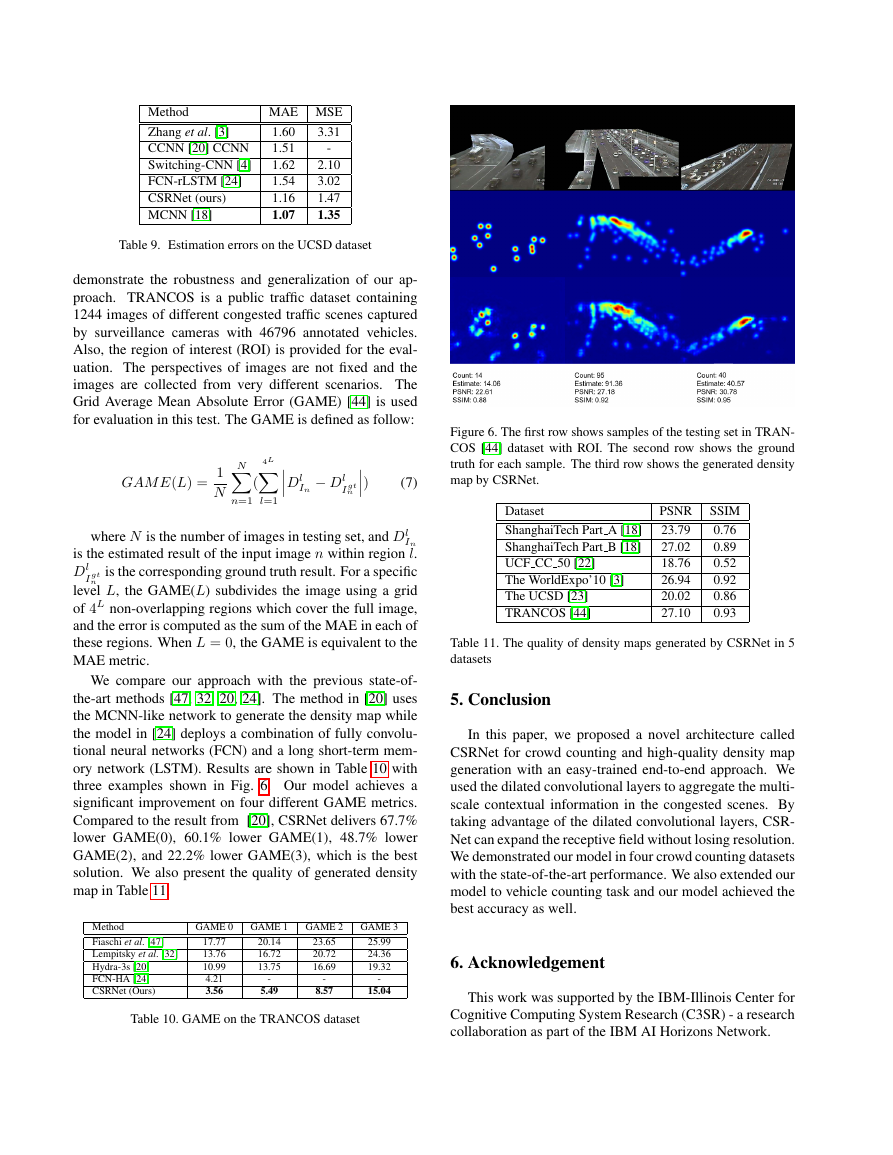








 2023年江西萍乡中考道德与法治真题及答案.doc
2023年江西萍乡中考道德与法治真题及答案.doc 2012年重庆南川中考生物真题及答案.doc
2012年重庆南川中考生物真题及答案.doc 2013年江西师范大学地理学综合及文艺理论基础考研真题.doc
2013年江西师范大学地理学综合及文艺理论基础考研真题.doc 2020年四川甘孜小升初语文真题及答案I卷.doc
2020年四川甘孜小升初语文真题及答案I卷.doc 2020年注册岩土工程师专业基础考试真题及答案.doc
2020年注册岩土工程师专业基础考试真题及答案.doc 2023-2024学年福建省厦门市九年级上学期数学月考试题及答案.doc
2023-2024学年福建省厦门市九年级上学期数学月考试题及答案.doc 2021-2022学年辽宁省沈阳市大东区九年级上学期语文期末试题及答案.doc
2021-2022学年辽宁省沈阳市大东区九年级上学期语文期末试题及答案.doc 2022-2023学年北京东城区初三第一学期物理期末试卷及答案.doc
2022-2023学年北京东城区初三第一学期物理期末试卷及答案.doc 2018上半年江西教师资格初中地理学科知识与教学能力真题及答案.doc
2018上半年江西教师资格初中地理学科知识与教学能力真题及答案.doc 2012年河北国家公务员申论考试真题及答案-省级.doc
2012年河北国家公务员申论考试真题及答案-省级.doc 2020-2021学年江苏省扬州市江都区邵樊片九年级上学期数学第一次质量检测试题及答案.doc
2020-2021学年江苏省扬州市江都区邵樊片九年级上学期数学第一次质量检测试题及答案.doc 2022下半年黑龙江教师资格证中学综合素质真题及答案.doc
2022下半年黑龙江教师资格证中学综合素质真题及答案.doc